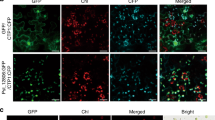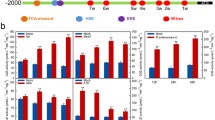Abstract
Phosphoenolpyruvate carboxykinase, a member of the lyase family, is involved in the metabolic pathway of gluconeogenesis in organisms. Although the major function of PEPCK in gluconeogenesis is well established, it is unclear whether this enzyme is involved in plant immunity. Here, we isolated and identified the pepper (Capsicum annuum) PEPCK (CaPEPCK1) gene from pepper leaves infected with Xanthomonas campestris pv. vesicatoria (Xcv). CaPEPCK1 was strongly expressed in pepper leaves during the incompatible interaction with avirulent Xcv and in response to environmental stresses, especially salicylic acid (SA) treatment. PEPCK activity was low in healthy leaves but dramatically increased in avirulent Xcv-infected leaves. Knock-down expression of CaPEPCK1 by virus-induced gene silencing resulted in high levels of susceptibility to both virulent and avirulent Xcv infection. CaPEPCK1 silencing in pepper compromised induction of the basal defense-marker genes CaPR1 (pathogenesis-related 1 protein), CaPR10 (pathogenesis-related 10 protein) and CaDEF1 (defensin) during Xcv infection. SA accumulation was also significantly suppressed in the CaPEPCK1-silenced pepper leaves infected with Xcv. CaPEPCK1 in an Arabidopsis overexpression (OX) line inhibited the proliferation of Pseudomonas syringae pv. tomato (Pst) and Hyaloperonospora arabidopsidis (Hpa). CaPEPCK1-OX plants developed more rapidly, with enlarged leaves, compared to wild-type plants. The T-DNA insertion Arabidopsis orthologous mutants pck1-3 and pck1-4 were more susceptible to the bacterial Pst and oomycete Hpa pathogens than the wild type. Taken together, these results suggest that CaPEPCK positively contributes to plant innate immunity against hemibiotrophic bacterial and obligate biotrophic oomycete pathogens.





Similar content being viewed by others
References
Aboul-Soud MAM, Cook K, Loake GJ (2004) Measurement of salicylic acid by a high-performance liquid chromatography procedure based on ion-exchange. Chromatographia 59:129–133
Bahrami AR, Chem CH, Walker RP, Leegood RC, Gray JE (2001) Ripening-related occurrence of phosphoenolpyruvate carboxykinase in tomato fruit. Plant Mol Biol 47:499–506
Burnell JN, Hatch MD (1988) Photosynthesis in phosphoenolpyruvate carboxykinase-type C4 plants: pathways of C4 acid decarboxylation in bundle sheath cells of Urochoa panicoides. Arch Biochem Biophys 260:187–199
Chanda B, Venugopal SC, Kulshrestha S, Navarre DA, Downie B, Vaillancourt L, Kachroo A, Kachroo P (2008) Glycerol-3-phosphate levels are associated with basal resistance to the hemibiotrophic fungus Colletotrichum higginsianum in Arabidopsis. Plant Physiol 147:2017–2029
Chandra-Shekara AC, Venugopal SC, Barman SR, Kachroo A, Kachroo P (2007) Plastidial fatty acid levels regulate resistance gene-dependent defense signaling in Arabidopsis. Proc Natl Acad Sci USA 104:7277–7282
Chapman KSR, Hatch MD (1983) Intracellular location of phosphoenolpyruvate carboxykinase and other C4 photosynthetic enzymes in mesophyll and bundle sheath protoplasts of Panicum maximum. Plant Sci Lett 29:145–154
Chen ZH, Walker RP, Acheson RM, Leegood RC (2002) Phosphoenolpyruvate carboxykinase assayed at physiological concentrations of metal ions has a high affinity for CO2. Plant Physiol 128:160–164
Chen ZH, Walker RP, Técsi LI, Lea PJ, Leegood RC (2004) Phosphoenolpyruvate carboxykinase in cucumber plants is increased both by ammonium and by acidification, and is present in the phloem. Planta 219:48–58
Choi DS, Hwang BK (2011) Proteomocs and functional analyses of pepper Abscisic acid-responsive 1 (ABR1), which is involved in cell death and defense signaling. Plant Cell 23:823–842
Choi HW, Hwang BK (2015) Molecular and cellular control of cell death and defense signaling in pepper. Planta 241:1–27
Choi DS, Hwang IS, Hwang BK (2012) Requirement of the cytosolic interaction between pathogenesis-related protein10 and leucine-rich repeat protein1 for cell death and defense signaling in pepper. Plant Cell 24:1675–1690
Clough SJ, Bent AF (1998) Floral dip: a simplified method for Agrobacterium-mediated transformation of Arabidopsis thaliana. Plant J 16:735–743
Delgado-Alvarado A, Walker RP, Leegood RC (2007) Phosphoenolpyruvate carboxykinase in developing pea seeds is associated with tissues involved in solute transport and is nitrogen-responsive. Plant Cell Environ 30:225–235
Dempsey DA, Vlot AC, Wildermuth MC, Klessig DF (2011) Salicylic acid biosynthesis and metabolism. Arabidopsis Book 9:e0156
Do HM, Lee SC, Jung HW, Sohn KH, Hwang BK (2004) Differential expression and in situ localization of a pepper defensin (CADEF1) gene in response to pathogen infection, abiotic elicitors and environmental stress in Capsicum annuum. Plant Sci 166:1297–1305
Dong X (2004) NPR1, all things considered. Curr Opin Plant Biol 7:547–552
Finnegan PM, Burnell JN (1995) Isolation and sequence analysis of cDNA encoding Phosphoenolpyruvate carboxykinase from the PCK-type C4 grass Urochloa panicoides. Plant Mol Biol 27:365–376
Finnegan PM, Suzuki S, Ludwig M, Burnell JN (1999) Phosphoenolpyruvate carboxykinase in the C4 monocot Urochloa panicoides is encoded by four differentially expressed genes. Plant Physiol 120:1033–1042
Friedlander TP, Regier JC, Mitter C, Wagner DL (1996) A nuclear gene for higher level phylogenetics: phosphoenolpyruvate carboxykinase tracks mesozoic-age divergences within Lepidoptera (Insecta). Mol Biol Evol 13:594–604
Furumoto T, Hata S, Izui K (1999) cDNA cloning and characterization of maize phosphoenolpyruvate carboxykinase, a bundle sheath cell-specific enzyme. Plant Mol Biol 41:301–311
Hanson RW, Reshef L (1997) Regulation of PEPCK gene expression. Annu Rev Biochem 66:581–611
Henry E, Fung N, Liu J, Drakakaki G, Coaker G (2015) Beyond glycolysis: GAPDHs are multi-functional enzymes involved in regulation of ROS, autophagy, and plant immune responses. PLoS Genet 11(4):e1005199
Hwang IS, An SH, Hwang BK (2011) Pepper asparagine synthetase 1(CaAS1) is required for plant nitrogen assimilation and defense responses to microbial pathogens. Plant J 67:749–762
Jung HW, Hwang BK (2000) Isolation, partial sequencing, and expression of pathogenesis-related cDNA genes from pepper leaves infected by Xanthomonas campestris pv. vesicatoria. Mol Plant-Microbe Interact 13:136–142
Kim YJ, Hwang BK (2000) Pepper gene encoding a basic pathogenesis-related 1 protein is pathogen and ethylene inducible. Physiol Plant 108:51–60
Kim DS, Hwang BK (2011) The pepper receptor-like cytoplasmic protein kinase CaPIK1 is involved in plant signaling of defense and cell-death responses. Plant J 66:642–655
Kim DS, Hwang BK (2014) An important role of the pepper phenylalanine ammonia-lyase gene (PAL1) in salicylic acid-dependent signaling of the defence response to microbial pathogens. J Experimental Bot 65:2295–2306
Kim DJ, Smith SM (1994) Molecular cloning of cucumber phosphoenolpyruvate carboxykinase and developmental regulation of gene expression. Plant Mol Biol 26:423–434
Lee PC, Lee SY, Hong SH, Chang HN (2002) Cloning and characterization of mannheimia succiniciproducens MBEL55E phosphoenolpyruvate carboxykinase (pckA) gene. Biotechnol Bioprocess Eng 7:95–99
Lee DH, Choi HW, Hwang BK (2011) The pepper E3 ubiquitin ligase RING1 gene, CaRING1, is required for cell death and the salicylic acid-dependent defense response. Plant Physiol 156:2011–2025
Leegood RC, Walter RP (2003) Regulation and roles of phosphoenolpyruvate carboxykinase in plants. Arch Biochem Biophys 414:204–210
Li H, Zhou G, Zhang HY, Li L, Liu JA (2010) In silico cloning and bioinformatic analysis of PEPCK gene in Fusarium oxysporum. Afr J Biotechnol 9:1864–1870
Liu Y, Schiff M, Dinesh-Kumar SP (2002) Virus-induced gene silencing in tomato. Plant J 31:777–786
Liu K, Ba X, Yu J, Li J, Wei Q, Han G, Li G, Cui Y (2006) The phosphoenolpyruvate carboxykinase of Mycobacterium tuberculosis induces strong cell-mediated immune responses in mice. Mol Cell Biochem 288:65–71
Malone S, Chen ZH, Bahrami AR, Walker RP, Gray JE, Leegood RC (2007) Phosphoenolpyruvate carboxykinase in Arabidopsis: changes in gene expression, protein and activity during vegetative and reproductive development. Plant Cell Physiol 48:441–450
O’Brien RM, Lucas PC, Forest CD, Magnuson MA, Granner DK (1990) Identification of a sequence in the PEPCK gene that mediates a negative effect of insulin on transcription. Science 249:533–537
Penfield S, Rylott EL, Gilday AD, Graham S, Larson TR, Graham IA (2004) Reserve mobilization in the Arabidopsis endosperm fuels hypocotyl elongation in the dark, is independent of abscisic acid, and requires PHOSPHOENOLPYRUVATE CARBOXYKINASE1. Plant Cell 16:2705–2718
Rylot EL, Gilday AD, Graham IA (2003) The gluconeogenic enzyme phosphoenolpyruvate carboxykinase in Arabidopsis is essential for seedling establishment. Plant Physiol 131:1834–1842
Sáez-Vásquez J, Raynal M, Delseny M (1995) A rapeseed cold-inducible transcript encodes a phospohoenolpyruvate carboxykinase. Plant Physiol 109:611–618
Schaaf J, Walter MH, Hess D (1995) Primary metabolism in plant defense. Plant Physiol 108:949–960
Shen W, Wei Y, Dauk M, Tan Y, Taylor DC, Selvaraj G, Zou J (2006) Involvement of a glycerol-3-phosphate dehydrogenase in modulating the NADH/NAD+ ratio provides evidence of a mitochondrial glycerol-3 phosphate shuttle in Arabidopsis. Plant Cell 18:422–441
Siedow JN, Day DA (2000) Respiration and photorespiration. In: Buchanan BB, Gruissem W, Jones RL (eds) Biochemistry and molecular biology of plants. American Society of Plant Physiologists Rockville, Maryland, pp 676–728
Singh R, Lemire J, Mailloux RJ, Appanna VD (2008) A novel strategy involved anti-oxidative defense: the conversion of NADH into NADPH by a metabolic network. PLoS ONE 3:e2682
Tamura K, Stecher G, Peterson D, Filipski A, Kumar S (2013) MEGA6: molecular evolutionary genetics analysis version 6.0. Mol Biol Evol 30:2725–2729
Tanaka S, Han X, Kahmann R (2015) Microbial effectors target multiple steps in the salicylic acid production and signaling pathway. Front Plant Sci 6:349
Venugopal SC, Chanda B, Vaillancourt L, Kachroo A, Kachroo P (2009) The common metabolite glycerol-3-phosphate is a novel regulator of plant defense signaling. Plant Signal Behav 4:746–749
Vlot AC, Dempsey DA, Klessig DF (2009) Salicylic acid, a multifaceted hormone to combat disease. Annu Rev Phytopathol 47:177–206
Walker RP, Leegood RC (1995) Purification, and phosphorylation in vivo and in vitro, of phosphoenolpyruvate carboxykinase from cucumber cotyledons. FEBS Lett 362:70–74
Walker RP, Leegood RC (1996) Phosphorylation of phosphoenolpyruvate carboxykinase in plant: studies in plant with C4 photosynthesis and Crassulacean acid metabolism and in germinating seeds. Biochem J 317:653–658
Walker RP, Trevanion SJ, Leegood RC (1995) Phosphoenolpyruvate carboxykinase from higher plants: purification from cucumber and evidence of rapid proteolytic cleavage in extracts from a range of plant tissues. Planta 196:58–63
Walker RP, Acheson RM, Técsi LI, Leegood RC (1997) Phosphoenolpyruvate carboxykinase in C4 plants: its role and regulation. Aust J Plant Physiol 24:459–468
Walker RP, Chen ZH, Tecsi LI, Famiani F, Lea PJ, Leegood RC (1999) Phosphoenolpyruvate carboxykinase plays a role in interactions of carbon and nitrogen metabolism during grape seed development. Planta 210:9–18
Walker RP, Chen ZH, Acheson RM, Leegood RC (2002) Effects of phosphorylation on phosphoenolpyruvate carboxykinase from the C4 plant Guinea grass. Plant Physiol 128:165–172
Watanabe M, Ohnishi J, Kanai R (1984) Intracellular localization of phosphoenolpyruvate carboxykinase in bundle sheath cells of C4 plants. Plant Cell Physiol 25:69–76
Acknowledgments
This work was carried out with the support of Cooperative Research Program for Agriculture Science & Technology (Project No. PJ00802701), Rural Development Administration, Republic of Korea.
Author information
Authors and Affiliations
Corresponding author
Electronic supplementary material
Below is the link to the electronic supplementary material.
Rights and permissions
About this article
Cite this article
Choi, D.S., Kim, N.H. & Hwang, B.K. The pepper phosphoenolpyruvate carboxykinase CaPEPCK1 is involved in plant immunity against bacterial and oomycete pathogens. Plant Mol Biol 89, 99–111 (2015). https://doi.org/10.1007/s11103-015-0354-6
Received:
Accepted:
Published:
Issue Date:
DOI: https://doi.org/10.1007/s11103-015-0354-6




